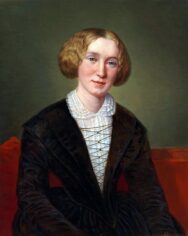 In the history of English literature, few names loom larger than that of George Eliot. Born Mary Ann Evans on November 22, 1819, in rural Warwickshire, England, she transcended the limitations of her time to become one of the most acclaimed novelists of the Victorian era. Her life, marked by intellectual fervor, personal upheavals, and literary triumphs, is a testament to the power of intellect, empathy, and perseverance.
In the history of English literature, few names loom larger than that of George Eliot. Born Mary Ann Evans on November 22, 1819, in rural Warwickshire, England, she transcended the limitations of her time to become one of the most acclaimed novelists of the Victorian era. Her life, marked by intellectual fervor, personal upheavals, and literary triumphs, is a testament to the power of intellect, empathy, and perseverance.
Early Years and Education
Mary Ann Evans was the third child of Robert Evans, a land agent, and his second wife, Christiana Pearson. Her upbringing in the rural countryside of England instilled in her a deep love for nature, which later found its expression in her writings. Despite modest beginnings, Evans exhibited exceptional intellectual curiosity from an early age. She devoured literature voraciously, demonstrating a precocious intellect that set her apart from her peers.
Evans received her formal education at several schools, including Mrs. Wallington’s School in Nuneaton, where she received a solid grounding in classical literature and languages. However, her education was cut short due to her mother’s illness, and she returned home to care for her family. This interruption in her formal schooling did not deter her thirst for knowledge. Instead, she continued her education through voracious reading and intellectual pursuits, laying the foundation for her future literary endeavors.
Career in Journalism and Translation
In her early twenties, Mary Ann Evans moved to Coventry, where she embarked on a career in journalism and translation. She became acquainted with a circle of intellectuals and writers, including Charles and Cara Bray, who would later influence her intellectual and philosophical development. Under the pseudonym “Marian Evans,” she began her career as a translator, rendering works by influential German thinkers such as Ludwig Feuerbach into English.
Her work as a translator brought her into contact with leading literary figures of the time, including the editor of the Westminster Review, John Chapman. Impressed by her intellect and writing prowess, Chapman offered her a position as assistant editor at the prestigious publication. This marked the beginning of Evans’s foray into the world of journalism, where she honed her skills as a writer and thinker.
Literary Beginnings and Adoption of the Pen Name “George Eliot”
It was during her tenure at the Westminster Review that Mary Ann Evans first began to experiment with fiction writing. In 1856, she published her first work of fiction, Scenes of Clerical Life, under the pseudonym “George Eliot.” The decision to adopt a male pen name was a strategic one, aimed at circumventing the gender biases prevalent in the literary world of the time. By concealing her true identity, Eliot hoped to ensure that her work would be judged on its own merits rather than being dismissed outright because of her gender.
The publication of Scenes of Clerical Life marked the beginning of George Eliot’s illustrious literary career. The collection of stories, set in the fictional English Midlands, showcased her keen observations of rural life, nuanced characterizations, and moral complexity. The critical acclaim and commercial success of the book established Eliot as a rising literary talent to be reckoned with.
A Literary Tapestry Unraveled: Eliot’s Key Works
Adam Bede (1859)
Eliot’s debut novel, Adam Bede, serves as a testament to her narrative prowess and keen observation of rural life in 19th-century England. Set in the pastoral landscape of the Midlands, the novel delves into the complexities of human relationships, morality, and redemption. Through the protagonist Adam Bede and his unrequited love for Hetty Sorrel, Eliot explores themes of forgiveness, empathy, and the inexorable march of time. The novel’s vivid portrayal of rural life and its inhabitants captivated readers and critics alike, establishing Eliot as a literary force to be reckoned with.
The Mill on the Floss (1860)
In The Mill on the Floss, Eliot’s narrative prowess reaches its full maturity as she navigates the tumultuous journey of the Tulliver siblings, Tom and Maggie. Set against the backdrop of the fictional village of St. Ogg’s, the novel explores themes of familial bonds, societal expectations, and the quest for individual autonomy. Through Maggie’s unyielding spirit and Tom’s steadfast adherence to tradition, Eliot crafts a narrative that transcends the confines of its time, resonating with readers across generations.
Silas Marner (1861)
Silas Marner stands as a departure from Eliot’s earlier works, both thematically and stylistically. Set in the rural village of Raveloe, the novel follows the eponymous protagonist, Silas Marner, a reclusive weaver whose life is irrevocably altered by a series of unforeseen events. Through Marner’s journey of redemption and the transformative power of love, Eliot explores themes of isolation, community, and the inherent goodness of humanity. The novel’s exploration of redemption and the triumph of the human spirit continues to resonate with readers, cementing its status as a timeless classic.
Middlemarch (1871-1872)
Widely regarded as Eliot’s magnum opus and often hailed as one of the greatest novels in the English language, Middlemarch stands as a testament to her narrative genius and keen insight into the human condition. A sprawling epic that explores the intricacies of provincial life in 19th-century England set in the fictional town of Middlemarch, the novel interweaves the lives of its inhabitants, offering a panoramic view of Victorian society. Through the multifaceted characters of Dorothea Brooke, Tertius Lydgate, and Will Ladislaw, among others, Eliot explores themes of ambition, idealism, and the pursuit of happiness. Through the novel’s richly detailed narrative and vividly drawn characters Eliot explores themes of marriage, ambition, and social change with unparalleled depth and insight. The breadth and depth of its narrative and characters continue to captivate readers, earning it a place among the greatest works of English literature.
Daniel Deronda (1876)
Like Middlemarch, Daniel Deronda represents Eliot at the height of her creative powers. The novel intertwines the stories of its eponymous protagonist, Daniel Deronda, a young man of mysterious origins, and Gwendolen Harleth, a headstrong and complex woman trapped in a loveless marriage. Set against the backdrop of Victorian England and the burgeoning Zionist movement, Daniel Deronda grapples with questions of identity, morality, and destiny with characteristic intellectual rigor and emotional depth.
Intellectual and Philosophical Influences
George Eliot’s literary works were informed by a diverse array of intellectual and philosophical influences. Central to her worldview was her rejection of orthodox Christianity in favor of a more humanistic and rationalistic philosophy. She was deeply influenced by the writings of Baruch Spinoza, whose pantheistic views resonated with her own belief in the interconnectedness of all things.
Eliot’s intellectual curiosity and philosophical inclinations found expression in her novels, which are characterized by their deep psychological insight, moral complexity, and philosophical depth. Her exploration of ethical dilemmas, social injustice, and the search for meaning and identity reflects her engagement with the pressing intellectual debates of her time.
Personal Life and Relationships
Despite her literary success, George Eliot’s personal life was marked by tumultuous relationships and personal struggles. In 1854, she embarked on a relationship with George Henry Lewes, a married man and fellow writer. Their unconventional union, though not legally recognized, endured for over two decades until Lewes’s death in 1878. Lewes, himself a towering figure in the Victorian literary scene, provided unwavering support and encouragement to Eliot throughout her career.
Following Lewes’s death, Eliot found love and companionship with John Walter Cross, a banker twenty years her junior. The couple married in 1880, but their happiness was short-lived, as Eliot’s health began to decline rapidly. She passed away on December 22, 1880, at the age of 61, leaving behind a legacy that continues to resonate with readers and scholars alike.
Legacy and Impact
George Eliot’s contributions to English literature are immeasurable. Through her groundbreaking novels, she challenged the conventions of Victorian society and expanded the boundaries of the novel as an art form. Her incisive social commentary, complex characters, and profound insights into the human condition have secured her a place among the literary giants of the Victorian era.
Moreover, Eliot’s advocacy for women’s rights and intellectual equality has inspired generations of writers and feminists. By daring to defy societal norms and pursue her intellectual ambitions, she paved the way for future generations of women to assert their voices and claim their rightful place in the literary canon.
George Eliot’s life and work exemplify the transformative power of literature to illuminate the human experience and challenge the prevailing norms of society. From her humble beginnings in rural England to her status as one of the most revered novelists of the Victorian era, Eliot’s journey is a testament to the enduring power of intellect, empathy, and artistic vision. As generations of readers continue to revisit her timeless novels and reflect on her profound insights into the human condition, George Eliot’s legacy endures as a beacon of literary excellence and moral clarity.
Commentary by Owen R. Howell, (c) 2024 for Apex Publications; all rights reserved, reprinted by permission.
